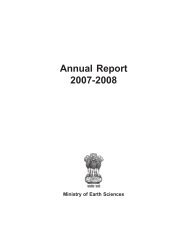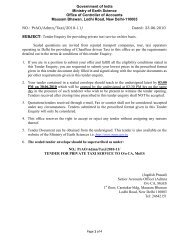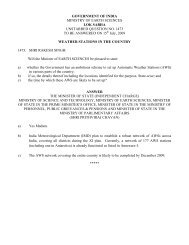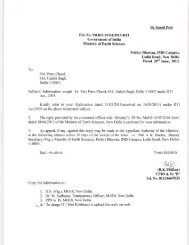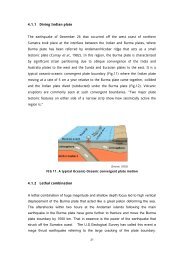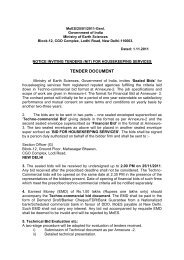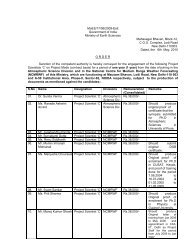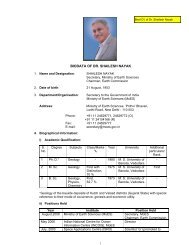1) Microzonation main Volume - Ministry Of Earth Sciences
1) Microzonation main Volume - Ministry Of Earth Sciences
1) Microzonation main Volume - Ministry Of Earth Sciences
- No tags were found...
You also want an ePaper? Increase the reach of your titles
YUMPU automatically turns print PDFs into web optimized ePapers that Google loves.
Probabilistic Seismic Hazard Analysis3.11 DATA COMPLETENESS ANALYSIS AND SEISMIC HAZARDPARAMETERUnlike deterministic seismic hazard analysis probabilistic analysis allows the uncertainties in the size, location,rate of recurrence and effect of earthquakes to be explicitly considered in the evaluation of seismic hazard. Thissection deals with the completeness analysis of seismic data and estimation of seismic hazard parameters for theseismic study area.3.11.1 Analysis of Completeness of Seismic DataImportant step in any earthquake data analysis is to investigate the available data set to assess its nature anddegree of completeness. Incompleteness of available earthquake data make it difficult to obtain fits ofGutenberg-Richter recurrence law (equation 4.1) that is thought to represent true long term recurrence rate.Almost all earthquake catalogs are biased against small shocks, because of seismographs station density or inthe early records population density (Stepp, 1972). Uncertainty in size of earthquakes produced by each sourcezone can be described by various recurrence laws. The Gutenberg-Richter recurrence law that assumes anexponential distribution of magnitude is commonly used with modification to account for minimum andmaximum magnitudes and is given by:LogN = a − bM(3.11)For a certain range and time interval, equation 4.1 will provide the number of earthquakes, (N) with magnitude,(M) where ‘a’ and ‘b’ are positive, real constants. ‘a’ describes the seismic activity (log number of events withM=0) and ‘b’ which is typically close to 1 is a tectonics parameter describing the relative abundance of large tosmaller shocks.The number of earthquakes per decade was divided in to five magnitude range such as 2 < M < 2.9; 3 < M < 3.9;4 < M < 4.9; M > 5. Table 3.6 describes the number of earthquakes reported in each decade (Stepp, 1972;Shankar and Sharma, 1997) since the beginning of the available historical record. Figure 3.14 shows thehistogram representing the data listed in Table 3.6 for the whole catalogue from 1807 through 2006. The wholecatalog shows that the period 1807 to 1976 the data is poorly reported which may be due to the lack ofobservations. However from 1976 – 1996 better recording of the data can be observed. From 1997 to 2006 lessdata this is attributed to non availability of earthquake data from GBA (as the organization does not release thelast 10 year data for the public consumption).Data Completeness AnalysisThe analysis in previous section highlight that the data is severely incomplete. This is to determine the mean rateof occurrence, λ = N/year, from the complete 200 year sample leads to underestimation of λ for the middle andlow intensity levels. To overcome this problem the method proposed by Stepp (1972) was adopted for thepresent investigation in order to check the completeness of the earthquake data. Analysis has been carried out bygrouping the earthquake data into several magnitude classes and each magnitude class is modeled as a pointprocess in time. By taking the advantage of the property of statistical estimation that variance of the estimate ofa sample mean is inversely proportional to the number of observations in the sample (Stepp, 1972). Thus thevariance can be made as small as desired by making the number of observation in theTable 3.6: Number of earthquakes reported in each decade since the beginning of the available historicalrecords for Bangalore regionTime inNumber of earthquakesyears 1





